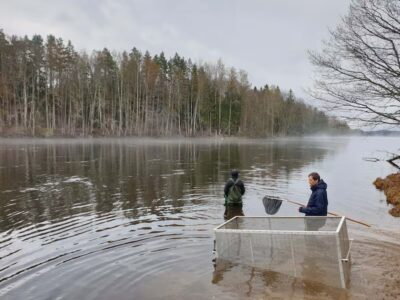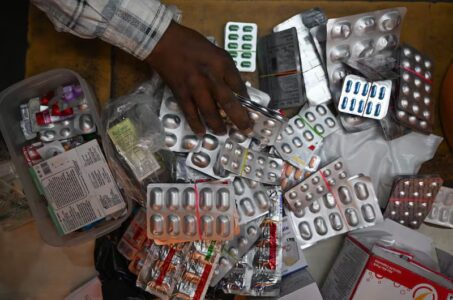Young salmon are more likely to carry out what are deemed as risk-taking behaviours, such as separating from the shoal, when exposed to levels of an anti-anxiety drug similar to those found in waterways because of pollution, research indicates.
Involving a drug called clobazam, which pollutes many rivers, the findings from scientists in Sweden highlight the wide-ranging effects on nature when drugs end up in the environment.
In the study, an implant that released fixed amounts of clobazam was applied to wild Atlantic salmon smoults, the term used for young salmon migrating to the sea for the first time. The animals’ movements were tracked after they were released into the River Dal in Sweden.
“We had different groups of the salmon smoults exposed to different concentrations or no chemical, and found this effect on migration to the Baltic Sea,” said Dr Michael Bertram, an assistant professor at the Swedish University of Agricultural Sciences and one of the authors of the study.

Separating from the crowd
Exposure to clobazam resulted in more salmon smoults reaching the sea, with the creatures passing through two hydrodams on their way to the sea more quickly, probably because they were shoaling less. Separate laboratory work confirmed that clobazam reduced shoaling, which is when fish group together for social reasons.
A reduction in shoaling could, the researchers said, increase the risk of individuals being picked off by predators.
While the clobazam was deliberately applied in the study, the concentrations were similar to those that the creatures might be exposed to in the environment, because the drug is present in waterways.
“These results suggest that clobazam exposure may have altered risk-taking behaviour in salmon smoults,” the researchers wrote in their paper, published today[Thurs] in Science.
“ … Taken together, our results suggest that clobazam-exposed smoults may have adopted a more risk-prone and solitary strategy than unexposed [smoults of the same species] when undertaking their seaward migration.
“We emphasise that any changes to migration dynamics are expected to have long-term consequences for the viability of contaminated populations.”
Previous studies have shown how widespread pharmaceutical pollution is, with more than 900 drugs or chemicals derived from them detected in the environment.
“A research study found pharmaceuticals were widespread across all continents, including Antarctica,” Dr Bertram said.
“These can affect animals not only in behaviour but in survival, reproduction, development and growth. I think animal behaviour is particularly useful to measure because it can be disrupted at very low concentrations.”
How drugs end up in the water
There are several sources of pharmaceutical pollution, said Prof David Hannah, professor of hydrology and UNESCO chair in water science at the University of Birmingham.
These include, he said, human waste, as excreted pharmaceuticals are released into the environment because sewage treatment plants fail to remove them.
Also, consumers may throw drugs that are not needed down the sink or flush them down the toilet, so-called “down-the-drain disposal of chemicals”, while some pharmaceutical manufacturing facilities improperly dispose of waste.
“Also, pharmaceuticals used in livestock can enter waterways through runoff from animal-feeding operations,” Prof Hannah said.

The time taken for drugs to break down in the environment varies, Dr Bertram said, from a few days to hundreds of days. Even when they degrade, more are introduced to replace them.
This is the case with, for example, the painkiller paracetamol, the presence in the environment of which has been analysed by Dr Wulan Koagouw, an environmental scientist at the National Research and Innovation Agency in Indonesia.
Dr Koagouw has found high concentrations in Jakarta Bay, and she said that it persisted in aquatic environments such as these because although it broke down, it was introduced “almost continuously”.
Paracetamol, she said, potentially disrupted physiological processes in marine organisms, and may also, for example, affect embryonic development and movement in fish larvae and embryos. Clams, oysters and mussels have also been found by previous research to be affected by paracetamol in the environment.
“These findings highlight the need for continued monitoring and mitigation of pharmaceutical pollutants in aquatic ecosystems to protect aquatic biodiversity,” she said.
Can people be affected too?
Aside from their effects on marine and freshwater life, the presence of pharmaceuticals in the environment raises the question of possible impacts on people.
Dr Bertram said that, at the concentrations usually found in waterways, pharmaceuticals would typically not have harmful effects.
“We aren’t exposed in the same way as, for example, a fish that’s swimming in a polluted river,” he said. “That’s not the case in countries where pharmaceutical production takes place.
“In these regions, such as India, Pakistan and China, there are areas that are heavily polluted. At these concentrations where there’s effluent there could well be effects on human health.”
Dr Koagouw said, however, that although typically concentrations of pharmaceutical substances in drinking water were low, there were concerns about “long-term, low-dose exposure”, particularly when it came to the risk of increased antibiotic resistance in bacteria.
“Furthermore, [hormone]-disrupting chemicals may pose risks to reproductive health over time,” she added.
Making change
Scientists said that multiple actions were needed to reduce levels of pharmaceutical pollution in freshwater and marine environments.
Improved wastewater treatment is one priority. Dr Koagouw said that a porous form of carbon called activated carbon, which has a large surface area, could filter water effectively, while a process called advanced oxidation could also “significantly enhance pharmaceutical removal”.
“Public education on safe medication disposal, such as take-back programmes, is crucial to prevent improper flushing or discarding of unused drugs,” she added.
Related to this, campaigns promoting responsible drug consumption and environmental awareness could be useful.
Also, pollution could be cut through policies that held manufacturers accountable for environmental emissions, such as the “polluter pays” principle in EU regulations, according to Dr Koagouw.



